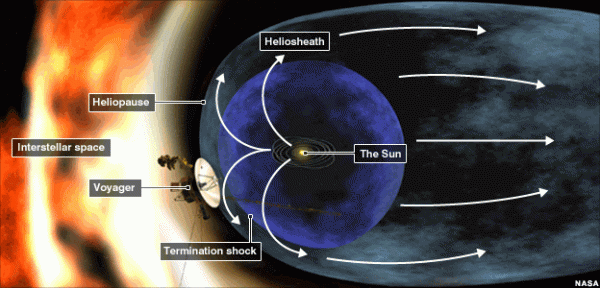
“We made it! 35 years and 13 billion miles.” Those were the words of project scientist Ed Stone today during a NASA news conference about the Voyager 1 spacecraft, which, after traveling the far reaches of our Solar System for decades on end, has finally passed the physical boundaries of the heliosphere and entered interstellar space.* (Yes, for real this time!)
It is truly, as astrophysicist Gary Zank said, “our first step into the galaxy.”
Watch the video below:
The twin Voyager spacecraft launched just a week apart in late summer 1977, embarking on a “grand tour” of the solar system like no exploration mission before — or since. The spacecraft gave us our first intimate views of the giant outer planets, and even showed us what we look like from beyond the orbit of Pluto.** Now, 36 years later and now almost 12 billion miles away, we are receiving signals back from the space between the stars.
Voyager 1 is thought to have actually made the transition in August of last year, and has been in a transition zone since then. A report on the analysis of this new data, an effort led by Don Gurnett and the plasma wave science team at the University of Iowa, Iowa City, is published in Thursday’s edition of the journal Science.
Within this region, the amount of energetic particles and ejected plasma originating from the Sun drop off significantly, and plasma pressures from outside our solar system increase. Ironically, it was a coronal mass ejection – CME – that allowed researchers to make this discovery.
Voyager 1 does not have a working plasma sensor, so scientists needed a different way to measure the spacecraft’s plasma environment to make a definitive determination of its location. A coronal mass ejection, or a massive burst of solar wind and magnetic fields, that erupted from the sun in March 2012 provided scientists the data they needed. When this unexpected gift from the sun eventually arrived at Voyager 1’s location 13 months later, in April 2013, the plasma around the spacecraft began to vibrate like a violin string. On April 9, Voyager 1’s plasma wave instrument detected the movement. The pitch of the oscillations helped scientists determine the density of the plasma. The particular oscillations meant the spacecraft was bathed in plasma more than 40 times denser than what they had encountered in the outer layer of the heliosphere. Density of this sort is to be expected in interstellar space. (Source)

“Now that we have new, key data, we believe this is mankind’s historic leap into interstellar space,” said Ed Stone, Voyager project scientist based at the California Institute of Technology, Pasadena. “The Voyager team needed time to analyze those observations and make sense of them. But we can now answer the question we’ve all been asking — ‘Are we there yet?’ Yes, we are.”

So what next? Scientists will continue to receive data from Voyager 1, knowing that what they see will be the exotic environment of space outside the heliosphere. Meanwhile Voyager will continue to soar outwards at tens of thousands of miles an hour, heading in the direction of a “nearby” star in the constellation Ophiuchus.
How nearby, you ask? It will get there in 40,000 years.
Perhaps by then we will have found a way to catch up to it…
Learn more on the NASA/JPL Voyager site here.
____________________
*So does this mean Voyager 1 has “left the solar system” as many outlets are reporting? Technically no, since there’s still a lot more stuff out there well beyond Voyager that are part of our solar system. But it has left the magnetic bubble created by the Sun and is thus now experiencing the external plasma environment of interstellar space, and that’s certainly a first. So come on, these scientists have been waiting over three decades for this event… I say let ’em have it. 🙂
**Could Voyager 1 ever make another “pale blue dot” image of Earth and the planets from beyond the heliosphere? While that would be truly momentous, sadly it can’t… in order to save space (no pun intended) the software for taking images has been removed from Voyager’s drive and it really doesn’t have the power to spare for such a maneuver anyway. (I actually posed this question via Twitter to the board of scientists during the press conference and that was the answer they gave!) Watch the full conference below:
Reblogged this on Signal + and commented:
Voyager is finally beyond the heliosphere! Am I a dork for being excited about this?
LikeLike
If being excited is wrong, I don’t wanna be right.
LikeLike
Yes, THIS IS INCREDIBLE!!!!!!!!!!!!!!!!!!!!!!!!!!!!!!!!!!!!!!!!!!!!!!!!!!!!!!!!!!!!!!!!!!!!!!!!!!!!!!!!!!!!!!!!!!!!!!!!!!!!!!!!!!!!!!!!!!!!!!!!!!!!!!!!!!!!!!!!!!!!!!!!!!!!
LikeLike
Heck of a milestone!
LikeLike
Three times the last year, now 2 times so far. I wonder how many times yet is it gonna leave the solar system. Voyager 1 has already been beyond the heliopause, as reported in May 2012. And the heliosphere goes to at least 200 AU, while Voyager 1 is currently 125,4 AU from the Sun. And the Oort cloud is going to at least 50 000 AU.
But yeah it sounds cool to say that man-made object has “left the solar system”. And cool makes money
LikeLike
The heliopause is a complicated place.
LikeLike
Reblogged this on Spherical Chickens in a Vacuum.
LikeLike